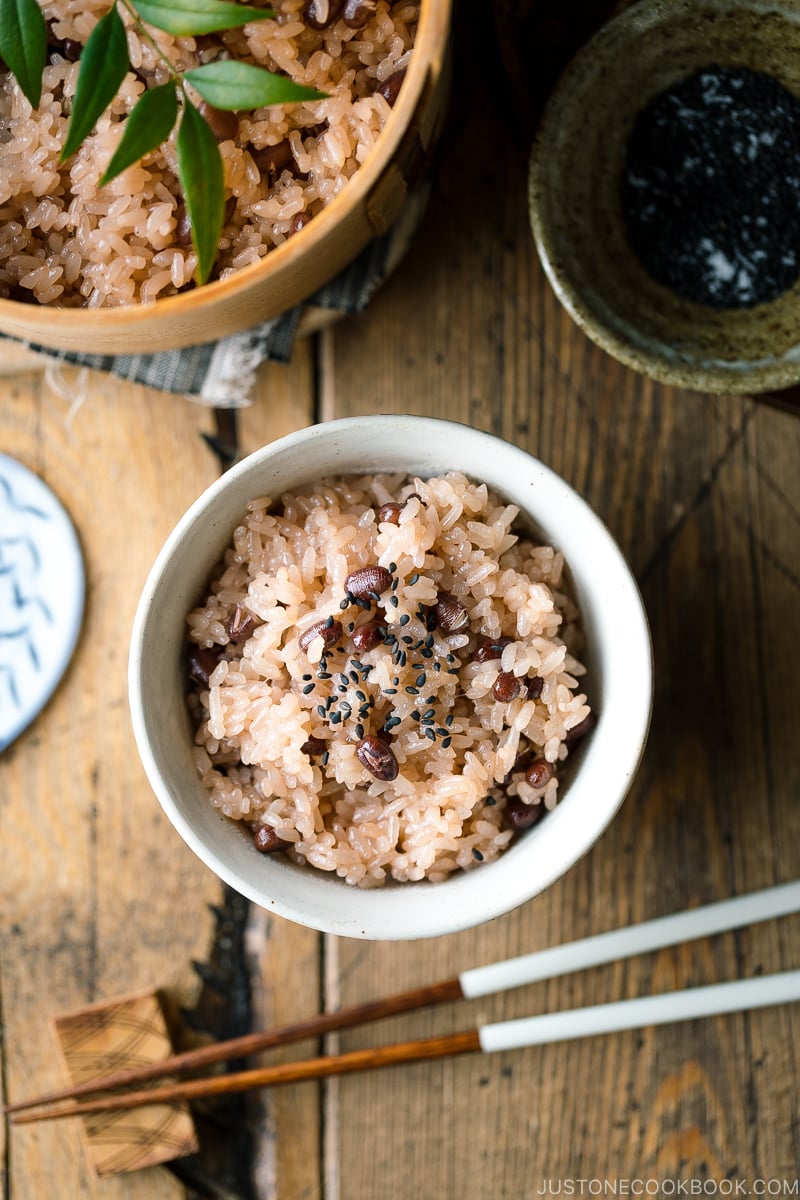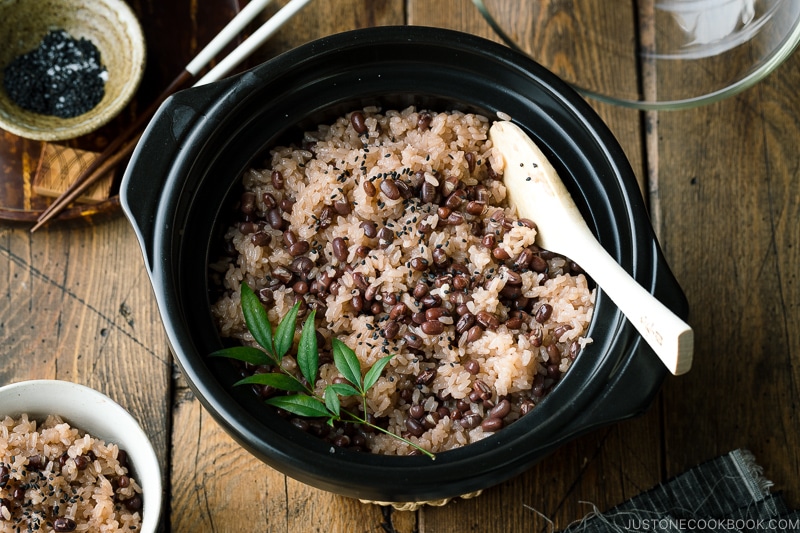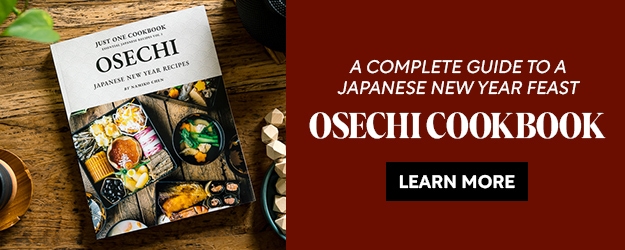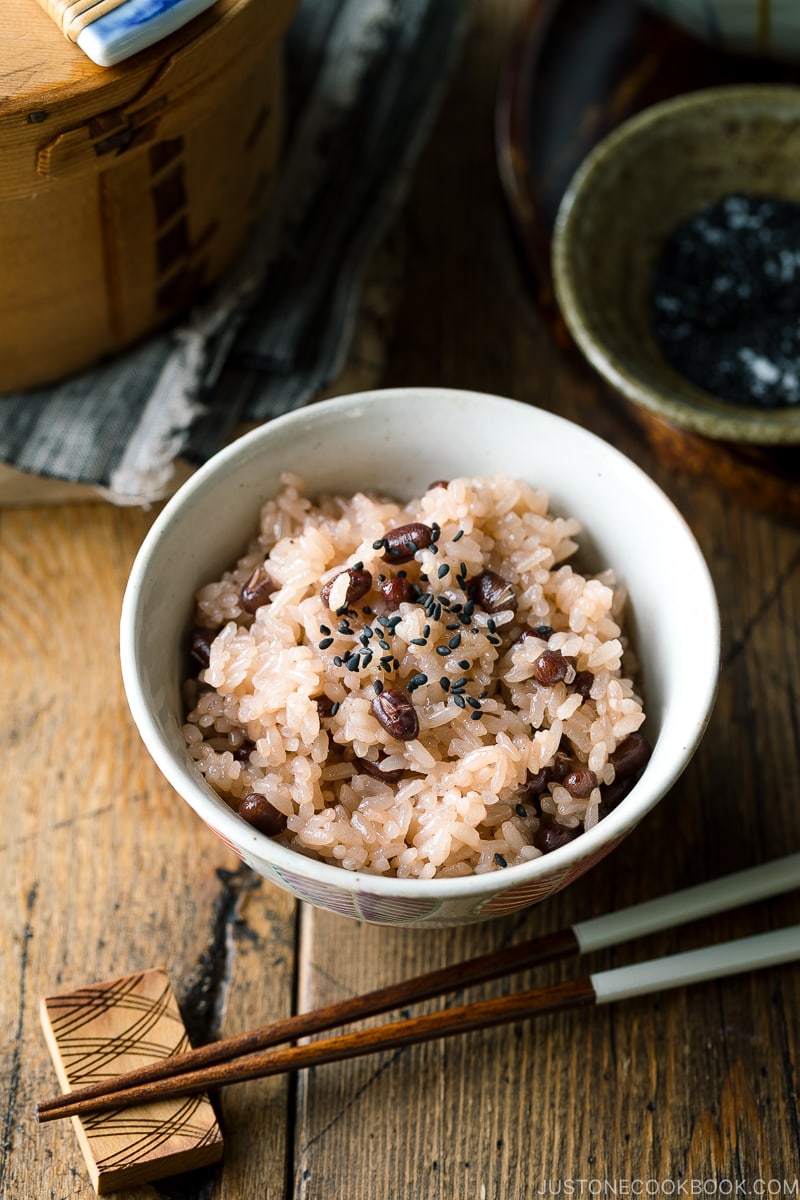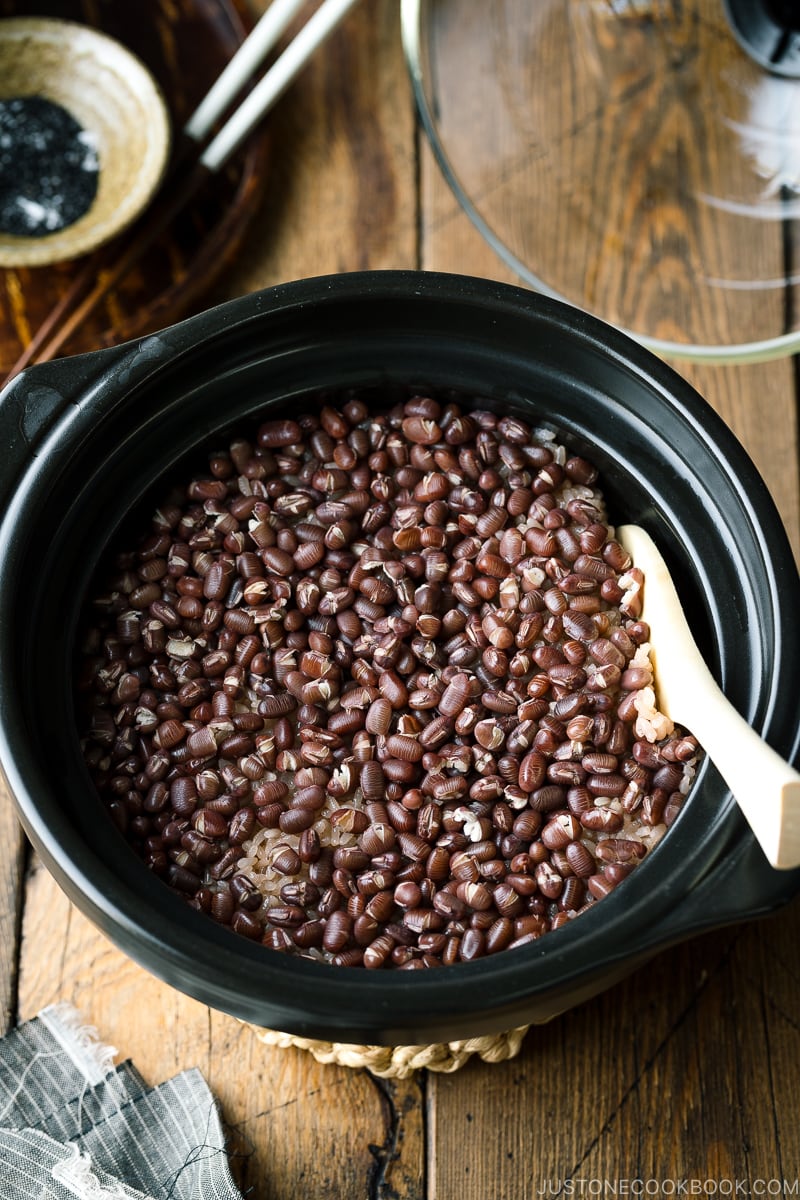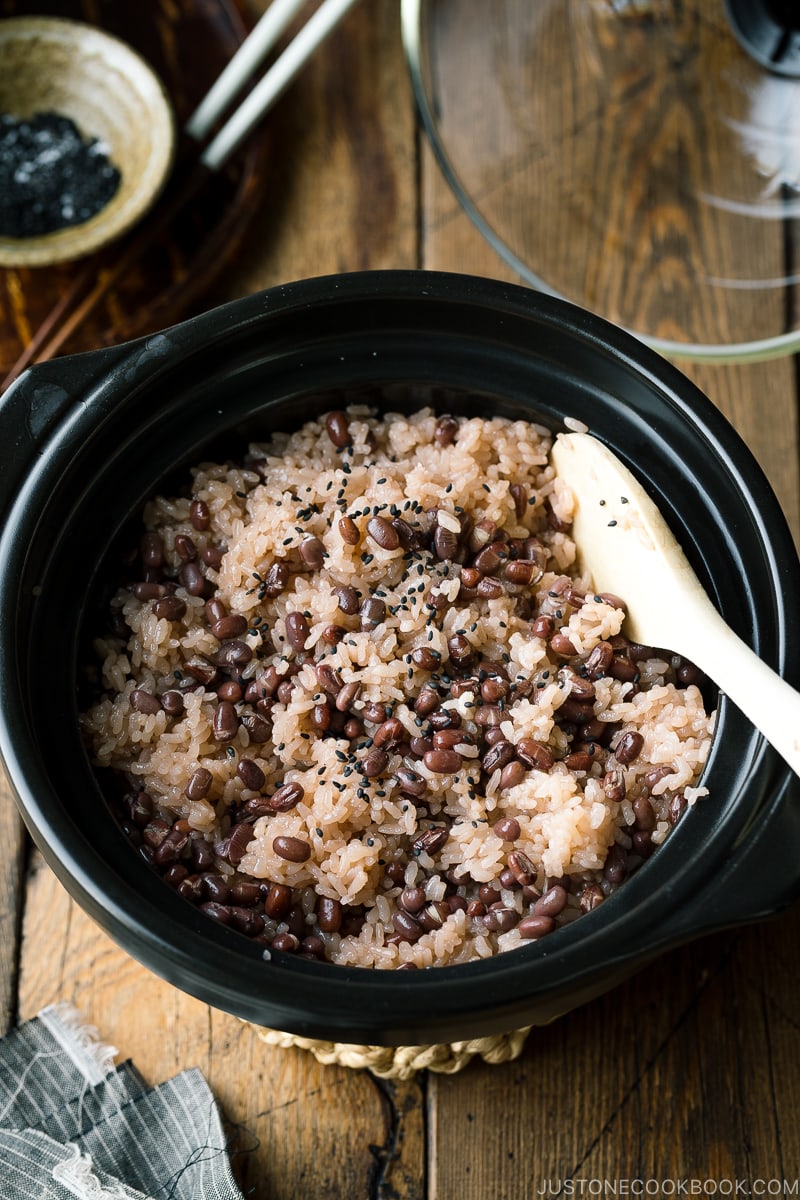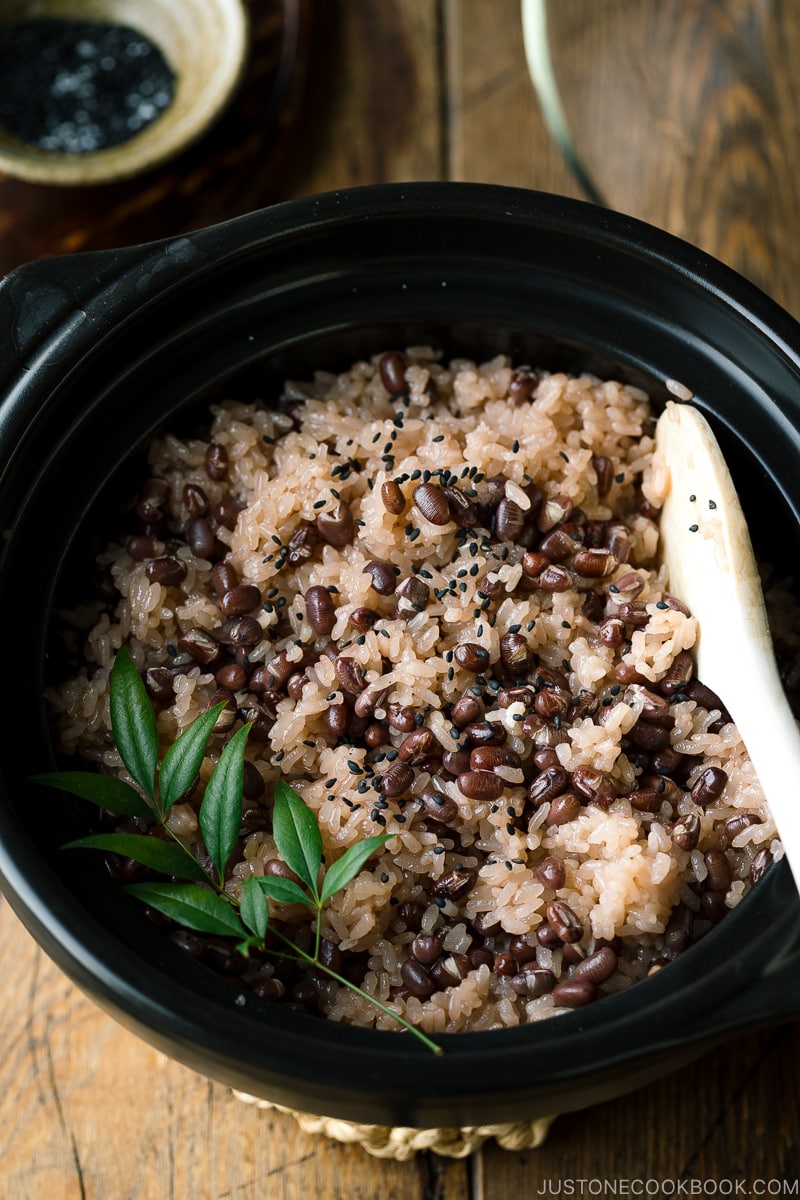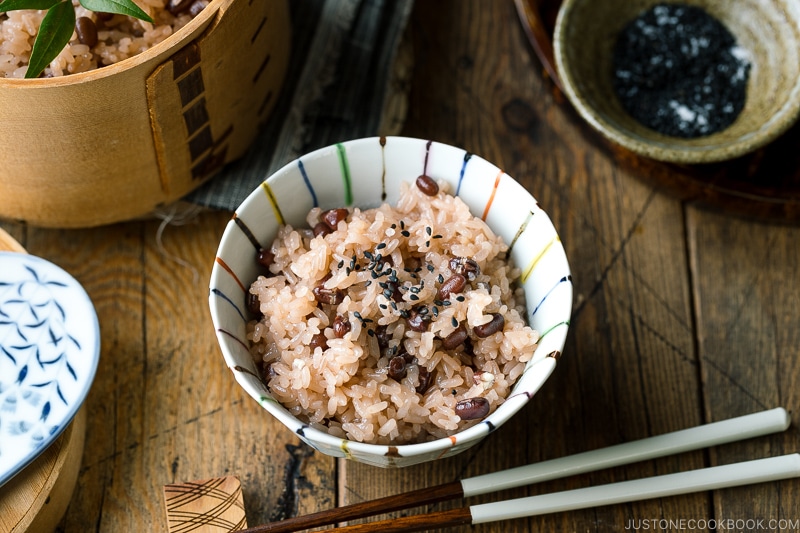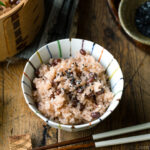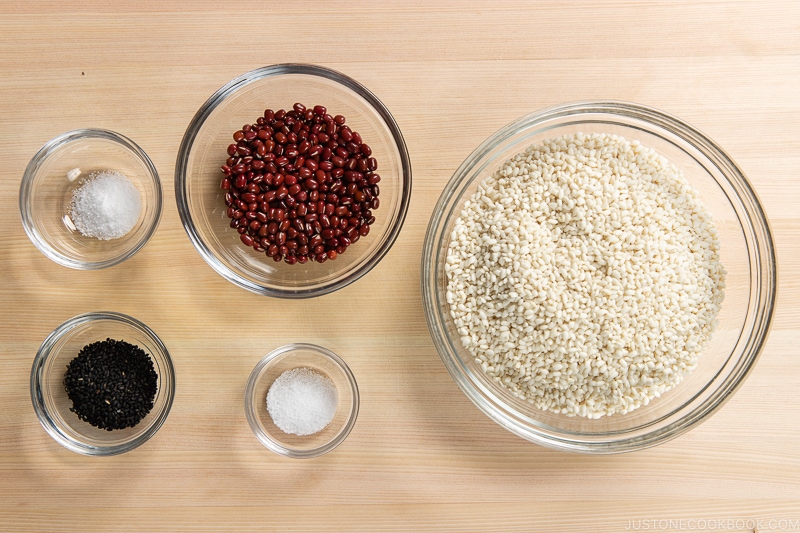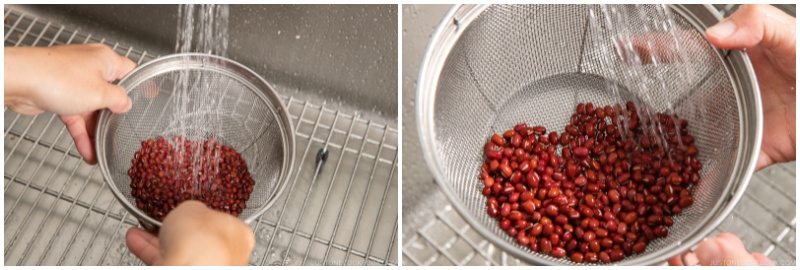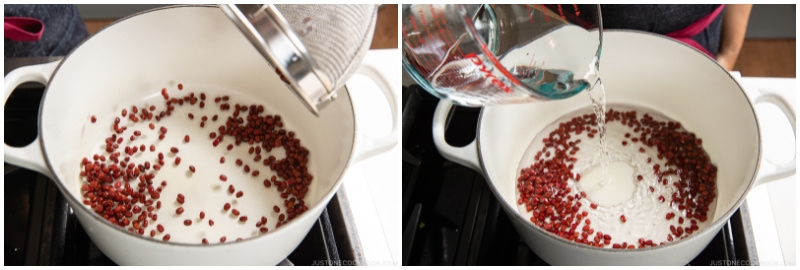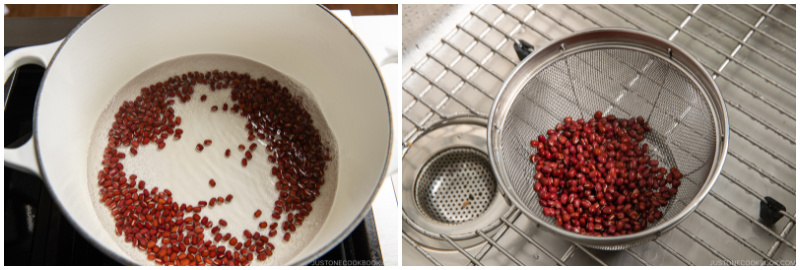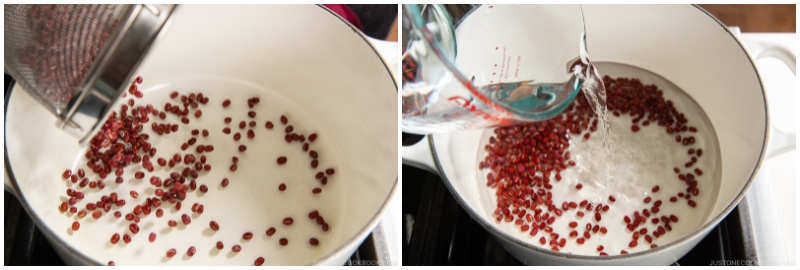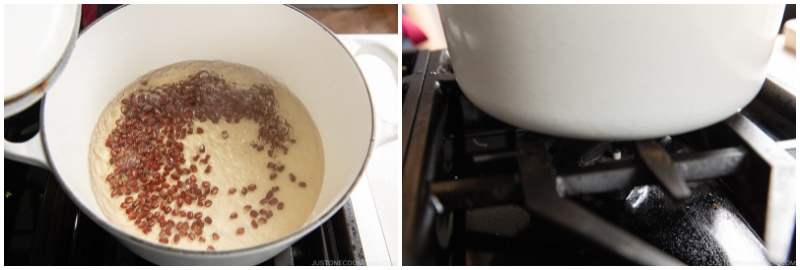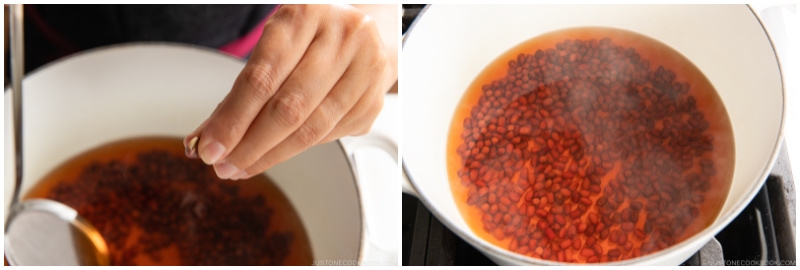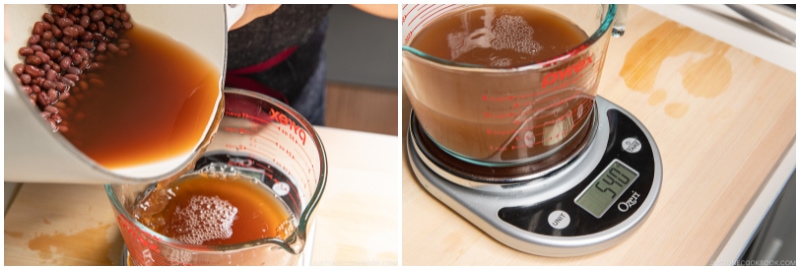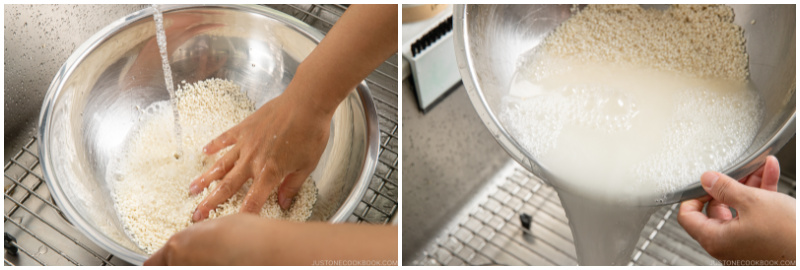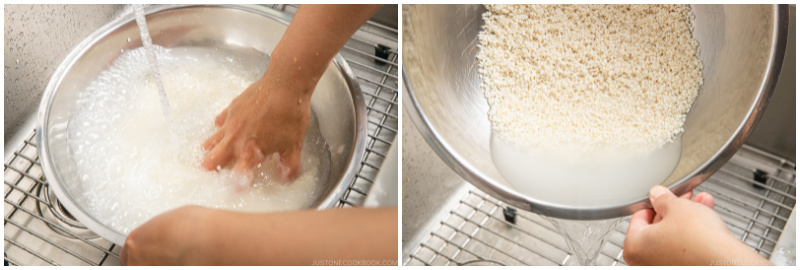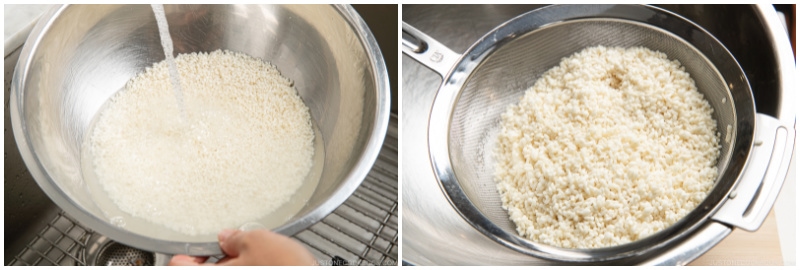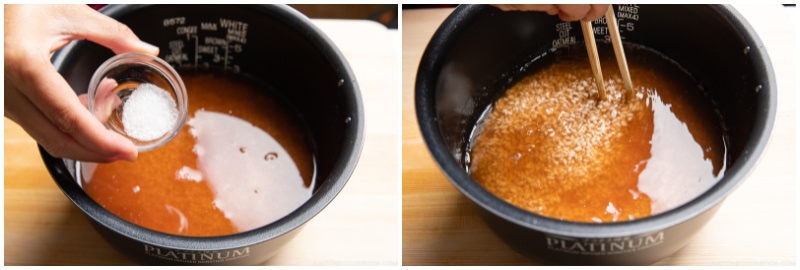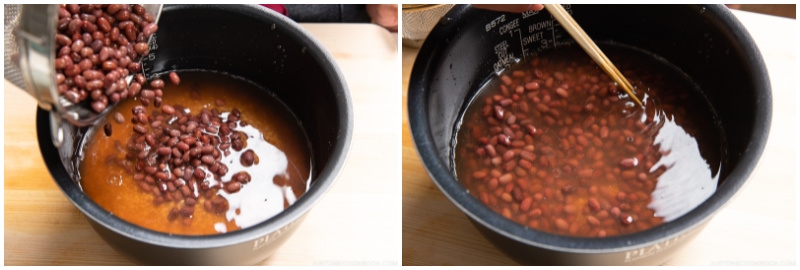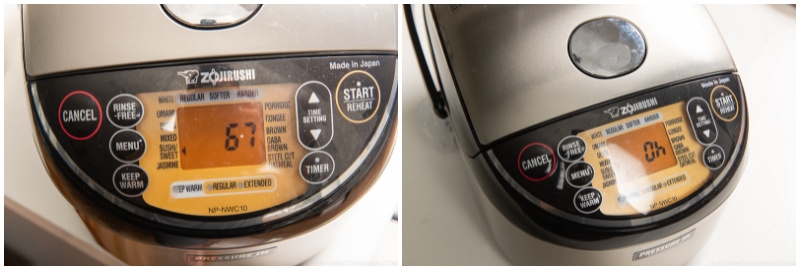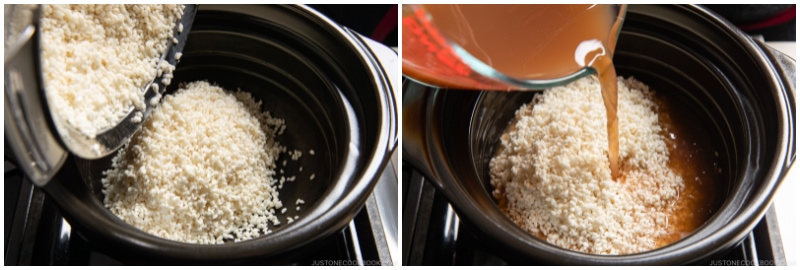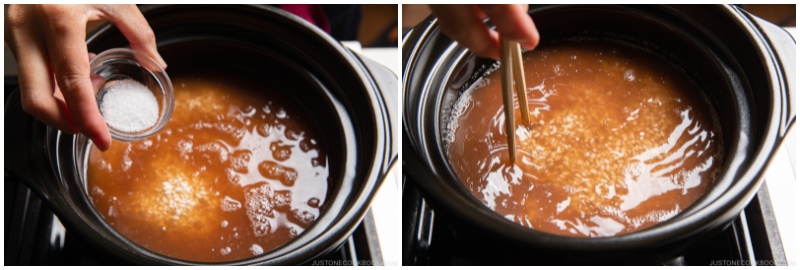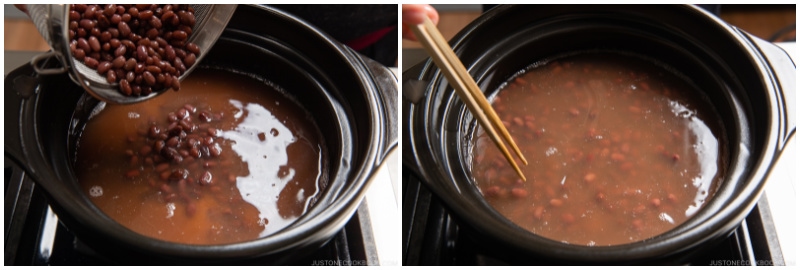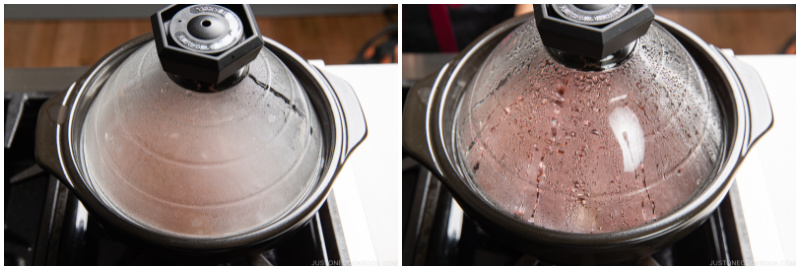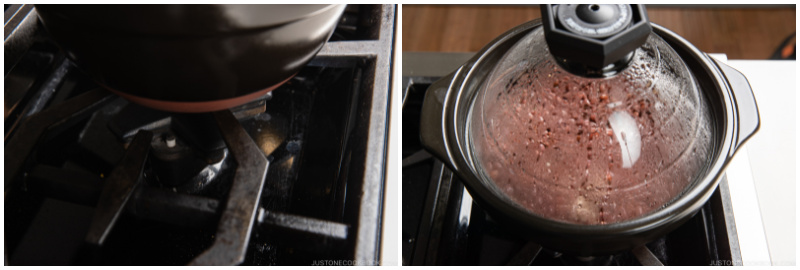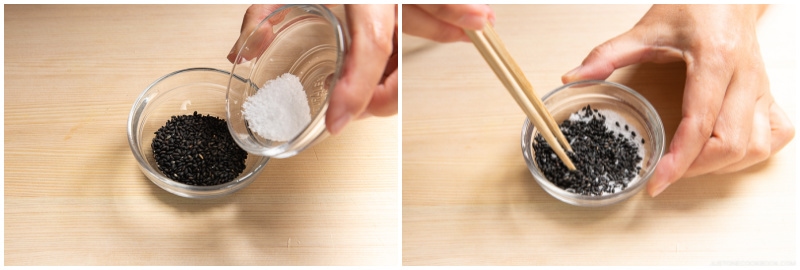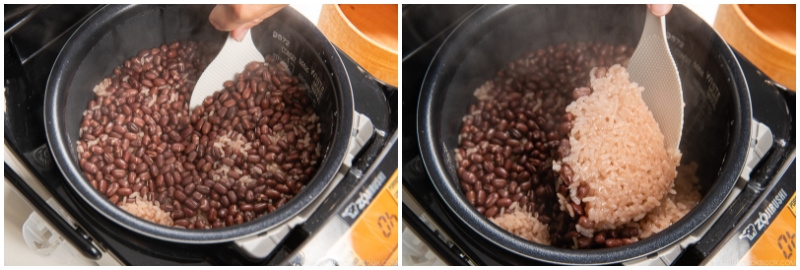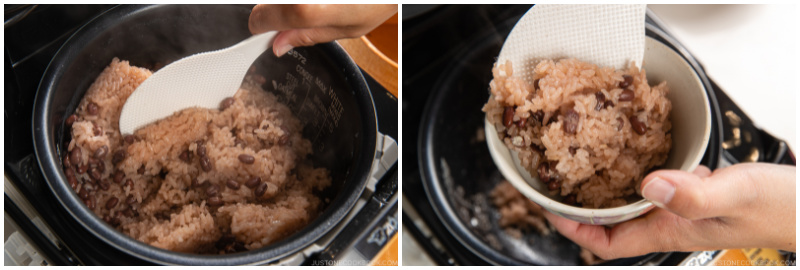What are some of the celebratory dishes in your culture? In Japan, we have quite a number of foods that we eat on special occasions. One of them is Sekihan (赤飯) or Japanese Red Bean Rice. To usher in birthdays, graduations, weddings, or Japanese New Year, let’s learn how to make this beautiful bean and rice dish today.
What is Sekihan?
Sekihan (赤飯) translates to “red rice” in Japanese as the glutinous rice is tinted with an attractive shade of red hue from cooking with azuki (adzuki) beans. The red color of the rice symbolizes happiness and prosperity. It’s a traditional dish served on happy and celebratory occasions such as New Year, the birth of a baby, birthdays, festivals, and weddings. Traditionally, sekihan is made of 100% glutinous rice (also called sweet rice or mochigome). It’s a sticky rice that is very filling and heavy on the stomach, so we don’t eat it regularly. There are also regional varieties of the sekihan. Some versions use a pinch of sugar instead of salt to give a sweet flavor, and some use other kinds of beans such as amanatto (sweetened bean confectionery, 甘納豆) or sasage (black cowpea beans, ササゲ) instead of azuki beans. The unique thing about sekihan is that we often serve it at room temperature. Regular steamed rice is never served at room temperature unless it’s in a form of rice balls (onigiri) or in a lunch box.
Azuki Red Beans in Japanese Cuisine
In Japanese cooking, azuki beans (or adzuki beans) are almost exclusively used in making Japanese sweets or pastries. The beans are boiled, mashed, sweetened, and then used as fillings in Daifuku Mochi, Manju, Dorayaki, Red Bean Ice Cream, Anpan, and so on. In this instance, however, azuki beans make a rare appearance in a non-sweet dish that is rather unique to Japanese cuisine. It replicates the ancient red rice in Japan and brings many great meanings to the culture.
Ingredients You’ll Need
Japanese glutinous rice (sweet rice, mochigome, もち米) azuki beans salt black sesame seeds – if your sesame seeds are not toasted, you can toast them in a non-greased frying pan until they begin to pop
How To Make Sekihan (Red Bean Rice)
Tips on Cooking Sekihan
Prepping the Ingredients
Use Japanese short-grain glutinous rice – It is not the same as Thai or Chinese long-grain glutinous rice. The color of glutinous rice is white as opposed to the semi-transparent color of the regular Japanese short-grain rice. Look for the rice packages indicating mochigome (もち米) in Japanese/Korean grocery stores. You can read more about it on our pantry page. Gently rinse the glutinous rice – Unlike regular white rice, glutinous rice grains are fragile and break easily, so don’t use a fine-mesh sieve/strainer to wash the rice. No need to soak glutinous rice – Glutinous rice absorbs water well, so you do not need to soak it unless you are going to steam the glutinous rice (not my recipe).
Cooking the Azuki Beans
Use a pot with a tight-fitting lid – The goal is to preserve enough azuki-cooking liquid that we will use to cook the rice. Use a tight-fitting lid to limit the evaporation. (Side note: Staub has a tighter fitting lid than Le Creuset!) Discard the first azuki-cooking liquid – Azuki beans release some astringency, so the first cooking water should be discarded. Cool beans and azuki-cooking liquid to room temp – Make sure you plan well so you have enough time for the beans and cooking liquid to cool completely. NEVER cook the glutinous rice with hot/warm cooking liquid. Keep the beans in the azuki-cooking liquid as hot liquid will continue to cook the beans. Separate the beans and liquid after cooling down. This will also prevent beans from getting wrinkled.
Cooking the Sekihan
Use a water-to-rice ratio of 1 to 1 by volume (NOT by weight) – Use 1 part glutinous rice, 1 part azuki-cooking liquid. To cook 3 rice cooker cups of glutinous rice, you will need 3 rice cooker cups liquid, which is 540 ml (180 ml x 3). I use a digital kitchen scale for to measure 540 ml precisely. Use gentle heat to cook – Use medium to medium-high heat to boil, but once boiling, the heat should be a gentle simmer to avoid burning the rice. Let steam for 20 minutes – This is not an optional, it’s a mandatory cooking step. The rice cooker’s “cooking time” includes this 20-minute steaming time in the program.
1. Do we need to use the Japanese variety of glutinous rice (sweet rice)?
Yes! It’s important to use the Japanese short-grain glutinous rice (sweet rice) for this recipe. It is not the same as Thai or Chinese long-grain glutinous rice. The color of Japanese glutinous rice is white as opposed to the semi-transparent color of the regular Japanese short-grain rice. Look for it in Japanese/Korean grocery stores. On the rice packages, the label should indicate mochigome or もち米. You can read more about it on our pantry page. Be gentle when you rinse the rice, as glutinous rice is easy to break.
2. Do we soak glutinous rice (sweet rice)?
When we cook standard Japanese short-grain rice, it is very important to soak the rice before cooking so the rice absorbs some water and becomes tender when cooked. However, when cooking glutinous rice (sweet rice), we do not need to soak it in water if it’s cooked in a rice cooker, pressure cooker, or a pot over the stovetop. In another word, you have to soak the glutinous rice if you’re going to steam it. Because glutinous rice is easy to absorb water, soaking is not necessary. If you soak the glutinous rice, and then cook it (in the water) in the rice cooker/pressure cooker/pot, it ends up soggy and mushy. When you steam glutinous rice, it’s best to soak at least 2 hours, or ideally overnight.
3. Do we soak azuki beans?
Soaking the dried azuki beans overnight or as long as 16 hours will help to reduce the cooking time. As azuki beans have a hard shell, soaking for a few hours or even overnight is not long enough to make a difference. These days many azuki bean packages recommend cooking beans straight from the package without soaking. However, there are other benefits of soaking beans. For example, the water helps absorb some of the complex sugars in the beans that cause gas.
4. Why don’t you use the steaming method?
Traditionally, glutinous rice dishes like sekihan and okowa (Japanese sticky rice) are made in a steamer and I believe the texture of the rice made in the steamer is the absolute best. Not mushy or soggy, just perfectly cooked rice. However, most Japanese households prepare sekihan using a rice cooker as it is convenient and fast, and offers a consistent result. The steaming method is a bit fussy with a few extra steps and it’s not as easy as other cooking methods. When I prepare sekihan for my family, I’ve only used my rice cooker, pressure cooker, and a pot over the stovetop, and I’ve never used a steamer. Therefore, from my own experience, I’ve decided to share my sekihan recipe using tools most people have.
5. Why do some recipes also add regular white rice?
You may have encountered recipes that use a mixture of glutinous rice and standard Japanese short-grain rice. Although sekihan is traditionally made with 100% glutinous rice, some people add a small portion of regular rice to reduce stickier/mushy texture when cooking in a rice cooker or on the stovetop (less problem with a steamer). Also, when sekihan is cooked with glutinous rice, the rice gets harder as it cools. Adding a small amount of regular white rice is supposed to ease that issue. I like sekihan with 100% glutinous rice but if you want to try combining glutinous rice and regular rice, I recommend the ratio of 2½ rice cooker cup of glutinous rice and ½ cup regular short-grain rice.
Let’s Celebrate with Sekihan
We have a saying in Japan—”Let’s have sekihan!”—that means “Let’s celebrate!” I hope you get a chance to make this tasty, auspicious dish for your next celebration.
Other Delicious Rice Recipes
Kuri Gohan (Chestnut Rice) Matsutake Gohan (Wild Pine Mushroom Rice) Takenoko Gohan (Bamboo Rice) Mame Gohan (Green Pea Rice) Sansai Gohan (Mountain Vegetable Rice)
Sign up for the free Just One Cookbook newsletter delivered to your inbox! And stay in touch with me on Facebook, Pinterest, YouTube, and Instagram for all the latest updates. Editor’s Note: The post was originally published on January 9, 2012. New images and video are added to the post and the content has been updated in May 2021.
